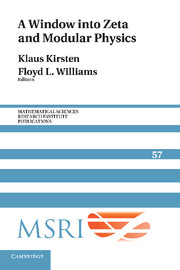Book contents
- Frontmatter
- Contents
- Introduction
- Lectures on zeta functions, L-functions and modular forms with some physical applications
- Basic zeta functions and some applications in physics
- Zeta functions and chaos
- Vertex operators and modular forms
- Applications of elliptic and theta functions to Friedmann–Robertson–Lemaître–Walker cosmology with cosmological constant
- Integrable systems and 2D gravitation: How a soliton illuminates a black hole
- Functional determinants in higher dimensions using contour integrals
- The role of the Patterson–Selberg zeta function of a hyperbolic cylinder in three-dimensional gravity with a negative cosmological constant
Applications of elliptic and theta functions to Friedmann–Robertson–Lemaître–Walker cosmology with cosmological constant
Published online by Cambridge University Press: 29 May 2025
- Frontmatter
- Contents
- Introduction
- Lectures on zeta functions, L-functions and modular forms with some physical applications
- Basic zeta functions and some applications in physics
- Zeta functions and chaos
- Vertex operators and modular forms
- Applications of elliptic and theta functions to Friedmann–Robertson–Lemaître–Walker cosmology with cosmological constant
- Integrable systems and 2D gravitation: How a soliton illuminates a black hole
- Functional determinants in higher dimensions using contour integrals
- The role of the Patterson–Selberg zeta function of a hyperbolic cylinder in three-dimensional gravity with a negative cosmological constant
Summary
1. Introduction
Elliptic functions are known to appear in many problems, applied and theoretical. A less known application is in the study of exact solutions to Einstein's gravitational field equations in a Friedmann–Robertson–Lemaître–Walker, or FRLW, cosmology [Abdalla and Correa-Borbonet 2002; Aurich and Steiner 2001; Aurich et al. 2004; Basarab-Horwath et al. 2004; Kharbediya 1976; Kraniotis and Whitehouse 2002]. We will show explicitly how Jacobi andWeierstrass elliptic functions arise in this context, and will additionally show connections with theta functions. In Section 2, we review the definitions of various elliptic functions. In Section 3, we record relations between elliptic functions and theta functions. In Section 4 we introduce the FRLW cosmological model and we then proceed to show how elliptic functions appear as solutions to Einstein's gravitational equations in sections 5 and 6. The author thanks Floyd Williams for helpful discussions.
2. Elliptic functions
An elliptic integral is one of the form, where P(x) is a polynomial in x of degree three or four and R is a rational function of its arguments. Such integrals are called elliptic since an integral of this kind arises in the computation of the arclength of an ellipse. Legendre showed that any elliptic integral can be written in terms of the three fundamental or normal elliptic integrals
which are referred to as normal elliptic integrals of the first, second and third kind, respectively. The parameter α is any real number and k is referred to as the modulus. For many problems in which real quantities are desired, 0 < k; x < 1, although this is not required in the above definitions (for k = 0 and k = 1, the integral can be expressed in terms of elementary functions and is therefore pseudo-elliptic).
Elliptic functions are inverse functions of elliptic integrals. They are known to be the simplest of nonelementary functions and have applications in the study of classical equations of motion of various systems in physics including the pendulum.
Information
- Type
- Chapter
- Information
- A Window into Zeta and Modular Physics , pp. 279 - 294Publisher: Cambridge University PressPrint publication year: 2010
Accessibility standard: Unknown
Why this information is here
This section outlines the accessibility features of this content - including support for screen readers, full keyboard navigation and high-contrast display options. This may not be relevant for you.Accessibility Information
- 2
- Cited by
